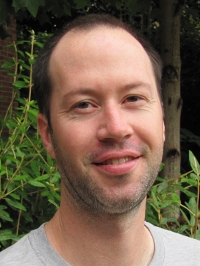NIMBioS Past Postdoctoral Fellow
Jake Ferguson
 Dates: August 2014 – December 2015
Dates: August 2014 – December 2015
Personal Website
Project Title: Modeling the role of seasonality on ecological populations
Jake Ferguson (Ph.D. Biology, Univ. of Florida, 2014) is using semi-discrete models to address questions about how the differing timescales of resource acquisition and reproduction inherent in animal populations can resolve existing paradoxes in population ecology and can improve predictions of animals coupled to seasonally varying environments. Upon completing his fellowship at NIMBioS, Dr. Ferguson accepted a position as a postdoctoral fellow at the Center for Modeling Complex Interactions at the University of Idaho, Moscow.
LiveScience Profile Q&A with Dr. Ferguson: Mysteries under the mundane help save species
NIMBioS Seminar: Stochastic models of populations in fluctuating environments
Video Interview:
Measuring seasonal effects on animal populations
Publications while at NIMBioS
- Bowden TS, Ferguson JM, Ward RV, Taper ML, Willey DW. 2015. Breeding season home range and habitat use of Mexican Spotted Owls (Strix occidentalis lucida) below the south rim of Grand Canyon National Park. The Wilson Journal of Ornithology, 127(4): 678-689. [Online]
- Ferguson JM, Carvalho F, Murillo-Garcia O, Taper ML, Ponciano JM. 2015. An updated perspective on the role of environmental autocorrelation in animal populations. Theoretical Ecology. [Online]
- Ferguson J, Ponciano JM. 2015. Evidence and implications of higher order scaling in the environmental variation of animal population growth. Proceedings of the National Academy of Sciences.
- Caughlin TT, Ferguson JM, Lichstein JW, Zuidema PA, Bunyavejchewin S, Levey DJ. 2014. Loss of animal seed disperal increases extinction risk in a tropical tree species due to pervasive negative density dependence across life stages. Proceedings of the Royal Society B: Biological Sciences, 282(1798): 20142095. [Online]
- Hopkins III JB, Ferguson JM, Tyers DB, Kurle CM. 2017. Selecting the best stable isotope mixing model to estimate grizzly bear diets in the Greater Yellowstone Ecosystem. PLoS ONE 12(5): e0174903 [Online]
NIMBioS
1122 Volunteer Blvd., Suite 106
University of Tennessee
Knoxville,
TN 37996-3410
PH: (865) 974-9334
FAX: (865) 974-9461
Contact NIMBioS


